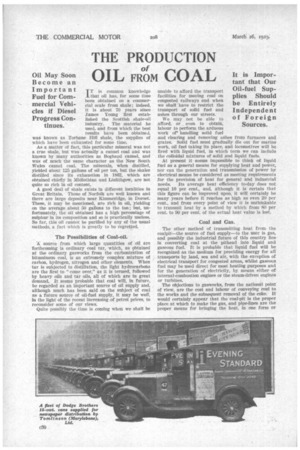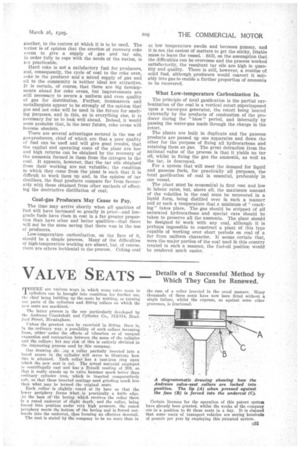THE PRODUCTION
Page 60

Page 61

If you've noticed an error in this article please click here to report it so we can fix it.
OIL FIZAI COAL
Oil May Soon Become an Important Fuel for Commercial Vehicles if Diesel Progress Con tinues.
IT is common knowledge that oil has, for some time been obtained on a commercial scale from shale; indeed, it is about 70 years since James Young first established the Scottish shale-oil industry. The material he used, and from which the best results have been obtained, was known as Torbane Hill shale, the supplies of which have been exhausted for some time.
As a matter of fact, this particular mineral was not a true shale, but was actually a cannel coal and was known by many authorities as Boghead cannel, and was of much the same character as the New South Wales cannel coal. The minerals, when distilled, yielded about 125 gallons of oil per ton, but the shales distilled since its exhaustion in 1862, which are obtained chiefly in Midlothian and Linlithgow, are not quite so rich in oil content.
A good deal of shale exists in different localities in Great Britain. Those of Norfolk are well known and there are large deposits near Kimmericlge, in Dorset. These, it may be mentioned, are rich in oil, yielding on the average about 50 gallons to the ton; but, unfortunately, the oil obtained has a high percentage of sulphur in its composition and so is practically useless. So far, this oil cannot be purified by any of the usual methods, a fact which is greatly to be regretted.
The Possibilities of Coal-oil.
'A source from which large quantities of oil are forthcoming is ordinary coal tar, which, as obtained at the ordinary gasworks from the carbonization of bituminous coal, is an extremely complex mixture of carbon, hydrogen, nitrogen and other elements. When tar is subjected to distillation, the light hydrocarbons are the first to "come over," as it is termed, followed by heavy oils and tar oils, all of which are in great demand. It seems probable that coal will, in future, be regarded as an important source of oil supply and, although much has been said on the subject of coal as a future source of oil-fuel supply, it may be well, in the light of the recent increasing of petrol prices, to reconsider some of our views.
Quite possibly the time is coming when we shall be
Sources.
We may not be able to .afford, or _ even to obtain, labour to perform the arduous work or handling solid fuel and clearing And removing ashes from furnaces and grates. Solid fuel must gradually die out for marine work, oil fuel taking its place, and locomotives will be fired with liquid fuel, in which term we can include the colloidal mixtures of solid and liquid fuels.
At present it seems impossible to think of liquid fuel as a general means for supplying heat and power, nor can the generation and transmission of power by electrical means be considered as meeting requirements for the provision of heat for general and industrial
needs. Its average heat efficiency to-day does not equal 10 per cent., and, although it is certain that this figure can be improved upon, it will certainly be many years before it reaches as high as even 20 per cent., and from every point of view it is unthinkable to transmit heat by a method by which from 80 per cent. to 90 per cent. of the actual heat value is lost.
Coal and Gas.
The other method of transmitting heat from the coalpit—the source of fuel supply—to the user is gas, and possibly the industrial future of this country lies in converting coal at the pithead into liquid and gaseous fuel. It is probable that liquid fuel will be recognized as the medium for providing energy for all transports by land, sea and air, with the exception of electrical transport for congested areas, whilst gaseous fuel may be used direct for most heating purposes and for the generation of electricity, by means either of internal-combustion engines or the steam-driven engines or turbines.
The objections to gasworks, from the national point of view, are the cost and labour of conveying coal to the works and the subsequent removal of the coke. It would certainly appear that the coal-pit is the proper place at which to make the gas, and pipe-lines are the proper means for bringing the heat, in one form or another, to the centres at which it is to be used. The writer is of opinion that the erection of • recovery coke ovens to give a supply of gas and tar oils, in order fully to cope with the needs of the nation, is not practicable.
Hard coke is not a satisfactory fuel for producers, and, consequently, the cycle of 'coal to the coke oven, t,oke to the producer and a mixed supply of gas and oil hi the community is 'neither ideal nor attractive. It is certain, of course, that there are big developments ahead for coke ovens, but improvements are still necessary to secure a uniform and even quality of gas for distribution. Further, ironmasters and metallurgists appear to be strongly of the opinion that gas and not coke will be used in the future for smelting purposes, and in this, as in everything else, it is necessary for us to look well ahead. Indeed, it would seem probable that, in the near future, coke ovens will become obsolete. '
There are several advantages secured in the use of gas-producers, chief of which are that a poor quality of fuel can be used and will give good results, that the capital and operating costs of the plant are low and high returns can be obtained by the recovery of the ammonia formed in them from the nitrogen in the coal. It appears, however, that the -tar oils obtained from their working are not valuable; the condition in which they come from the plant is such that it is difficult to work them up and, in the opinion of tar distillers, the final products compare far from favourably with those obtained from other methods of effecting the destructive distillation of coal.
Coal-gas Producers May Cease to Pay.
The time may arrive shortly when all qualities of fuel will have increased so greatly in price—and lowgrade fuels have risen in cost in a far greater proportion than have other and better qualities—that there will not be the same saving that there was in the use of producers.
IA-m-ternperature carbonization, on the Tare of it, should be a simple process. Many of the difficulties of high-temperature working are absent, but, of course. there are others incidental to the process. Coking coal
at low temperature swells and becomes gummy, and it.is not.the easiest of matters to get the sticky, friable mass to leave the vessel. Still, on the assumption that the difficulties can be overcome and the process worked satisfactorily, the resultant tar oils are high in quantity and quality. There is still, however, a residue of solid fuel, although producers would convert it suitably into gas to enable a further proportion of ammonia to be recovered.
What Low-temperature Carbonization Is.
The principle of total gasification is the partial carbonization of the coal in a vertical retort superimposed upon a water-gas generator, the retort being heated externally by the products of combustion of the producer during the " blow " period, and internally by passing the water-gas made through the charge in the retort.
The plants are built in duplicate and the gaseous products are passed up one apparatus and down the other for the purpose of fixing all hydrocarbons and retaining them as gas. The great detraction from the national value of the process is that it yields no tar oil, whilst in fixing the gas the ammonia, as well as the tar, is destroyed. For a system that will meet the demand for liquid and gaseous fuels, for practically all purposes, the total gasification of coal is essential, preferably in one vessel.
The plant must be economical in first cost and low in labour rates, but, above all, the maximum amount of the volatiles in the coal must be recovered in a liquid form, being distilled over in such a manner and at such a temperature that a minimum of cracking" takes place. The gas should be stripped of All saturated hydrocarbons and special care should be taken to preserve all the ammonia. The plant should he designed towork with any coal, although it is perhaps impossible to construct a plant of this type capable of working over short periods on coal of a far from uniform character. It seems certain that, were the major portion of the coal used in this country treated in such a manner, the fuel-oil position would be rendered much easier.




























































































































